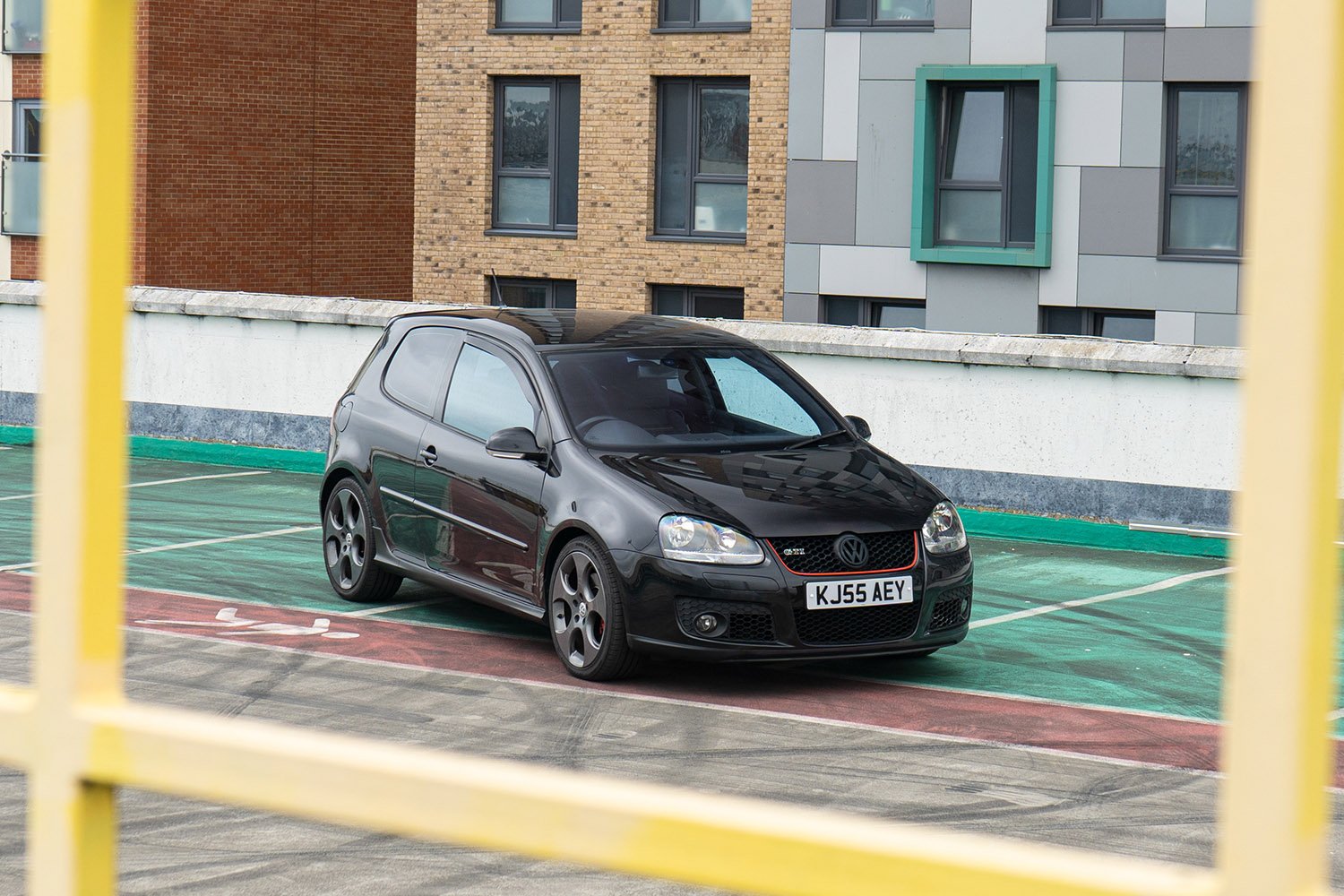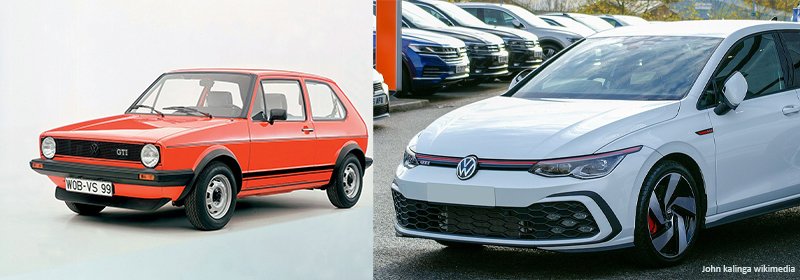
Once upon a time, in a galaxy far away the very first hatchback was created. They were small, practical and about as user friendly as a car could be.
They were however missing something in the way of kick and that's where the hot hatch came into play. Today we're looking at the evolution of 5 hot hatches from their first offering to their latest.
The golf GTI

Ask anyone about hot hatches and they will very quickly start to talk about the Golf GTI for as long as you're willing to listen.
The Golf GTI when it arrived in 1976 was revolutionary both critically and commercially, its brilliant handling and willingness to go anywhere was loved almost universally and it's still rated as one of the best pure drivers cars over 40 years later.
The first generation GTI used a 1.6 litre, naturally aspirated engine that produced 110hp and 140nm. This gave the pocket rocket a 0 - 60 time of just 9 seconds, and a top speed of around 115mph. Not too quick by todays standards but for the mid 70's this was lightning fast for a small European hatchback. The lightweight GTI weighed in at under 900kg and had little in the way of luxuries compared to todays hatchback with its compact design and front wheel drive system keeping weight to a minimum.
Through its 8 generations it's had a rollercoaster ride in popularity - hitting rock bottom with the mk4 before the mk5 stepped in and saved the day. The following incarnations built upon the 5th generations formula to deliver something truly exciting and a world apart from the GTI's now humble looking origins. Fast Forward to today and the Golf GTI has become a monster of a car in comparison. The GTI is undoubtedly the benchmark that all other hot hatches measure themselves against.
Making use of a 2 litre turbocharged powerplant producing circa 240hp, the modern GTI can reach 60mph in just 6.3 seconds. Compared to the original there's simply no competition on paper. The 8th generation looks meaner, goes faster and makes the Mk 1 look like a tin can on wheels. That's not an insult to the original but a mark of the progress VW have made over the years - which is exactly how it should be.
For those who want even more power, the Golf R takes things one step further giving you 320hp and all wheel drive.
Ford Focus RS

Remember when the first Ford Focus came out? how modern it looked? of course you do. The Focus was Fords successor to the outgoing and dated Escort and was a huge jump in both quality and drivability. The futuristic shape and great handling through the range made it an instant hit on the market with the Focus becoming a best seller in no time at all.
When the RS finally released in 2002 it was a massive upgrade from the base model, sharing only 30% of the original cars components. Wide arches, an aggressive stance and a 2.0 litre turbocharged engine made the RS a formidable hatchback in its day. The lightweight components and performance parts which included Brembo brakes and OZ wheels weren't just for show and worked together to make the first generation RS an all time classic.
Following on from the first generation, The next installment in the family tree upped the power to 300hp from it's 2.5 litre, 5 cylinder Volvo powerplant. With an awesome soundtrack and even beefier body kit the Mk2 RS was as cool as any hot hatch ever was - The RS500 edition of course was the ultimate rendition.
The third and, for the time being, final generation went on sale in 2016. This variant uses a 2.3 litre EcoBoost engine that produces 350hp and is hands down one of the best hot hatches of this generation. The first fast Ford to use an all wheel drive system since the Escort Cosworth, The system on the RS is seriously good. Power is sent to the wheels in a 70/30 split in favour of the rears which allows the focus RS the benefits of rear wheel drive with the traction capabilities of an all wheel drive vehicle. There's even a drift mode to spice things up.
Renault Clio

The Renault 5 Gordini was one of the first hot hatches available, being sold 2 months before the GTI hit the market. What followed was a turbocharged version and eventually the iconic Renault 5 turbo. The 5 was replaced in 1990 and discontinued altogether in 1996. That replacement was the Renault Clio.
Debuting in 1991 in the UK the original Clio was another hit for the French brand, winning multiple awards and being named European car of the year in 1991. It wasn't long before a hot hatch variant was created in the form of the 1.8 litre RS and the 130mph,16 valve came shortly after that.
The one everyone wanted though? the Renault Clio Williams. With its deep blue paint and gold alloy wheels the Williams is an unmistakable sight on the roads, although you won't see one very often. Based on the 16v with improvements all round the Williams Clio uses a 2.0 litre Naturally aspirated engine to deliver around 150hp to the front wheels and will reach over 130mph. This iconic piece of automotive history even had a stint as the F1 safety car in 1996 - back when Williams were front runners in the sport and Mercedes didn't win everything.
The second generation RS 172 built on the winning formula. Following on from this we had the 182,197 and 200 all of which were powered by 2.0 naturally aspirated engines. The latest offering however has dropped the traditional 2.0 NA unit in favour of a 1.6 litre turbocharged unit that, in its most powerful form, has managed an impressive 217hp/280nm in the Mk4 220 trophy.
Much has improved with the modern Clio RS from a driver convenience point of view. These improvements come in the form of selectable drive modes, air con and clever motorsport derived technology under the hood. The power and straight line speeds haven't tumbled in quite the same way as the Golf GTI and Focus RS but that's what's so appealing about the Clio, it's got a recipe and it sticks to it - roughly.
Renault have since released a Mk 5 but are refusing to release an RS model. Lets hope this isn't the end of the road for the little French hot hatch.
Seat Leon Cupra

While the Golf had got a little boring with the Mk4, there was a newcomer making a bit of a bang. Compared to the Golf of its era the Seat Leon Cupra was worlds apart in terms of excitement - the wider body and striking alloys alongside the awesome colour palette were turning enthusiasts away from the Golf and into the drivers seat of its Spanish cousin.
Sharing multiple components with the Golf the Seat Cupra R came with the same 1.8 litre turbocharged engine and was good for 230hp with a 0 - 60 of just 6.5 seconds. Seen as a less premium version of the Golf and orientated more towards the younger generation, the original Leon helped take Seat into the mainstream.
The second generation got a little more bulk and even more power before the third generation dropped in 2013. The latest and greatest Leon Cupra has managed to build even further on the second generations improvements to deliver a seriously hot hatch that can fight amongst the big boys.
Compared to the original car the third generation is a technological masterpiece with advanced driver aids, a high tech interior and blistering performance. The standard Cupra manages to outpace it's closest rival the Golf GTI with the 3 door SC version managing 60mph in just 5.6 seconds. The fastest version of the Leon, the Cupra R comes with the same 306hp as the Golf R as well as an upgraded chassis and brakes however unlike the all wheel drive Golf, the Leon only comes with front wheel drive in hatchback form.
There's good news for Cupra fans too, the fourth incarnation is now available. For the moment you can only order the 1.4 Hybrid that produces around 240hp and is, unfortunately, not available with a manual transmission. There is a 2.0 litre turbocharged variant on the way in the near future which will drop the hybrid element and give you another 60hp to play with.
Honda Civic Type R

Last but not least we have the Japanese entrant. The type R division at Honda are known for making high revving, exciting cars with the Civic being no exception to the rule. The first Civic Type R was only available in Japan and was an awesome car thanks to the clever engineering behind it. The 1.6 litre naturally aspirated engine made an astonishing 185hp - one of the highest horsepower per litre counts for a naturally aspirated engine ever. The original Civic type R was by no means a basic car with a monocoque chassis and Recaro seats as standard but at the same time it was a nice clean design from a time before the aero revolution.
The Civic Type R burst onto the UK scene in 2001 with a bang and quickly made a name for itself as one of the best hot hatches on the hatchback market, amassing a huge following within the modified car scene. We are now on the fifth generation of the Type R and between now and then there's been a world of technological advancements both visually and behind the scenes.
The 5th generation Civic Type R (FK8) manages to maintain the core features of the original car whilst being completely overhauled in almost every way. The first thing you'll notice when comparing the two is that the new Civic has a LOT more in the aero department and is littered with all sorts of vents, air ducts and carbon. If any car was a transformer, it would be the FK8. it's ok though, this means that the car cuts through the air better than ever and generates much more downforce.
The engine has also developed from the furious 1.6 NA lump into a 2.0 turbocharged inline 4 with VTEC that puts out over 300hp, this meant that the latest Civic was able to set an all time lap record for FWD cars at the Nürburgring in 2017, a record that stood for over 2 years until the Megane RS piped up. The best part about the Civic however is the automatic gearbox, specifically the fact that there isn't one. Honda only offer the car with a 6 speed manual transmission which is exactly what you want in a car designed for fun.
Do you have a favorite hatch? let us know on our social media channels and make sure to check back often for more blogs, tips and videos.





 Spidersnet
Spidersnet